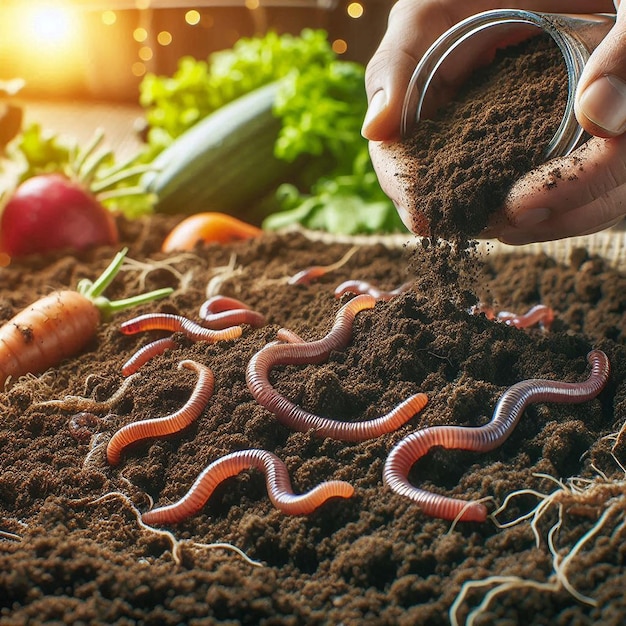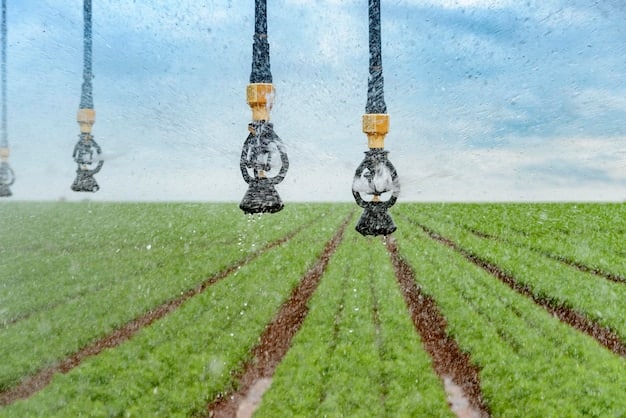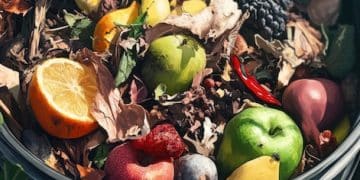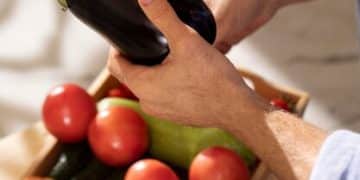Long-Term Benefits of Sustainable Agriculture in the US

Sustainable agriculture in the US offers profound long-term benefits, including enhanced environmental health through soil enrichment and biodiversity preservation, strengthened rural economies, improved public health via safer food, and increased resilience to climate change, securing a more stable and prosperous future for the nation.
Understanding what are the long-term benefits of sustainable agriculture in the US is crucial as the nation grapples with climate change, resource depletion, and growing food demands. This approach to farming extends beyond mere yield, offering a holistic vision for ecological balance, economic viability, and social equity.
Environmental Resilience and Ecosystem Health
Sustainable agriculture plays a pivotal role in fostering environmental resilience and preserving the delicate balance of ecosystems across the United States. Unlike conventional farming, which often relies on monocultures and synthetic inputs, sustainable methods prioritize the long-term health of the land, water, and air, seeing them as integral components of a thriving agricultural system.
One of the most significant environmental benefits is the improvement of soil health. Practices such as no-till farming, cover cropping, and crop rotation significantly reduce soil erosion, increase organic matter, and enhance microbial activity. These improvements lead to better water infiltration and nutrient retention, making farms more resilient to droughts and extreme weather events. Healthier soils act as natural carbon sinks, helping to mitigate climate change by sequestering atmospheric carbon dioxide. This process is vital for reducing greenhouse gas concentrations, offering a tangible positive impact on global warming.
Enhanced Biodiversity and Pollinator Protection
Biodiversity is a cornerstone of a healthy ecosystem, and sustainable agriculture actively promotes it. By integrating diverse crop rotations, maintaining natural buffer zones, and reducing pesticide use, sustainable farms create habitats for a wide range of flora and fauna. This includes vital pollinators like bees and butterflies, whose populations have seen alarming declines due to habitat loss and pesticide exposure.
- Diverse crop rotations prevent pest outbreaks, reducing reliance on chemical interventions.
- Hedgerows and riparian buffers provide critical habitats for beneficial insects and wildlife.
- Reduced use of synthetic pesticides protects non-target species, including crucial pollinators.
- Integrating livestock in rotational grazing systems helps to manage pastures and enrich soil naturally.
The protection of pollinators is not just an environmental concern; it directly impacts food security. Many of the crops essential for human consumption rely on animal pollination. Preserving these species ensures the continued production of fruits, vegetables, and nuts, supporting a diversified and resilient food supply for the US population.
Additionally, sustainable practices minimize water pollution by reducing runoff of excess nutrients and pesticides into rivers, lakes, and oceans. This safeguards aquatic ecosystems and ensures cleaner drinking water sources for communities. Air quality also benefits from reduced emissions associated with fossil-fuel intensive conventional farming and enhanced carbon sequestration.
In essence, the environmental benefits of sustainable agriculture are interconnected, creating a positive feedback loop that strengthens natural systems, enhances farm productivity without compromising future generations, and builds long-term climate resilience. These ecological advantages lay the groundwork for a more stable and robust agricultural future in the US.

Economic Stability and Rural Development
Beyond its ecological advantages, sustainable agriculture offers substantial long-term economic benefits, particularly for rural communities in the US. By reducing reliance on external inputs and fostering local food systems, it cultivates a more resilient and self-sufficient agricultural economy.
A key economic benefit is the reduction of production costs. Sustainable farmers often minimize the use of expensive synthetic fertilizers, pesticides, and herbicides by adopting practices like cover cropping, natural pest control, and composting. This reduces chemical expenditures and also lowers fuel costs associated with less intensive tillage. Over time, these reduced input costs can significantly improve the profitability of farm operations, making them more financially viable.
Diversification and Market Access
Sustainable agriculture often encourages diversification of crops and livestock, moving away from monoculture systems. This diversification provides multiple income streams, spreading risk and making farms less vulnerable to market fluctuations or crop failures. For instance, if one crop struggles due to weather or disease, other crops can help maintain income.
- Farmers can tap into niche markets for organic, locally sourced, and specialty products, which often command premium prices.
- Direct-to-consumer sales, such as farmers’ markets and Community Supported Agriculture (CSA) programs, eliminate intermediaries, allowing farmers to capture a larger share of the retail price.
- Agri-tourism and on-farm experiences can create additional revenue streams, attracting visitors and boosting local economies.
Furthermore, sustainable agriculture fosters robust local food systems. When food is grown, processed, and distributed locally, it stimulates local economies by keeping money within the community. This supports local businesses, creates jobs in processing, distribution, and retail, and strengthens community bonds. The increased demand for local products can also lead to the revitalization of rural infrastructure and services.
By promoting fair labor practices and supporting family farms, sustainable agriculture also contributes to social equity within agricultural sectors. It helps retain younger generations on the farm by offering more profitable and meaningful work, countering the trend of rural youth out-migration. This strengthens the social fabric of rural areas and preserves generational farming knowledge.
In summary, sustainable agriculture’s economic advantages extend from the individual farm level to broader rural development. It builds more stable and profitable farm businesses, diversifies income opportunities, and invigorates local economies, ensuring a more prosperous future for American farmers and their communities.
Improved Public Health and Food Safety
The long-term benefits of sustainable agriculture in the US extend significantly to public health and overall food safety. By prioritizing natural processes and minimizing harmful chemicals, sustainable farming practices contribute to a healthier food supply and reduced exposure to environmental toxins.
One primary advantage is the reduction of pesticide residues in food. Conventional farming often uses synthetic pesticides to control pests and diseases, which can leave residues on produce. While regulated, concerns persist about the long-term cumulative effects of exposure to these chemicals on human health. Sustainable and organic farming methods, by contrast, rely on natural pest control, crop rotation, and beneficial insects, significantly reducing or eliminating the need for synthetic pesticides.
Nutrient Density and Dietary Health
There is growing evidence suggesting that sustainably grown foods may offer higher nutritional value. Healthy, biologically active soil, rich in organic matter and diverse microorganisms, can enhance the uptake of vital nutrients by plants. This can lead to produce with a greater concentration of vitamins, minerals, and antioxidants compared to crops grown in depleted soils.
- Produce from healthy soils may offer higher levels of Vitamin C, iron, magnesium, and other essential nutrients.
- Reduced exposure to pesticide residues lessens the risk of related health issues, including neurological and developmental problems.
- Emphasis on varied crops in sustainable systems encourages a more diverse human diet, which is linked to better overall health.
- Pasture-raised animal products (e.g., meat, dairy) from sustainable farms often have healthier fatty acid profiles and higher vitamin content.
Moreover, sustainable agricultural practices minimize the risk of antibiotic resistance. Conventional livestock operations often use antibiotics preventatively or as growth promoters, contributing to the development of antibiotic-resistant bacteria. Sustainable animal husbandry practices, which emphasize animal welfare, proper nutrition, and hygienic conditions, reduce the need for routine antibiotic use, thereby safeguarding the effectiveness of these critical medicines for human health.
By reducing agricultural runoff, sustainable farming also protects water sources, directly impacting public health. Less nitrogen, phosphorus, and pesticide runoff means cleaner drinking water and healthier aquatic environments, reducing the incidence of waterborne illnesses and harmful algal blooms.
In conclusion, the shift towards sustainable agriculture is a strategic investment in the nation’s public health. It provides safer, potentially more nutritious food, reduces exposure to harmful chemicals, and contributes to a healthier environment, ultimately benefiting consumers and communities across the US.
Climate Change Mitigation and Adaptation
Sustainable agriculture offers critical long-term benefits in the fight against climate change, serving as both a powerful tool for mitigation and a vital strategy for adaptation. As the US faces increasing climate variability, the resilience built by sustainable practices becomes indispensable.
A primary way sustainable agriculture mitigates climate change is through carbon sequestration. Healthy soils, developed through practices like cover cropping, no-till farming, and organic matter amendment, act as significant carbon sinks, drawing carbon dioxide from the atmosphere and storing it in the soil. This process directly reduces greenhouse gas concentrations, helping to curb global warming. Regenerative agriculture, a subset of sustainable farming, specifically focuses on maximizing this carbon capture potential.
Building Farm Resilience to Extreme Weather
Climate change brings more frequent and intense extreme weather events, such as droughts, floods, and heatwaves. Sustainable farming methods enhance the resilience of agricultural systems to these challenges. Improved soil health leads to better water retention during dry periods and reduced runoff during heavy rains, making farms more stable in unpredictable conditions.
- Enhanced soil organic matter improves soil structure, root penetration, and water-holding capacity, making crops more resilient to drought.
- Cover crops and diverse rotations protect soil from erosion during heavy rainfall events and reduce nutrient leaching.
- Agroforestry practices, like integrating trees into farming systems, can provide shade, reduce wind erosion, and enhance biodiversity, buffering against extreme temperatures.
- Diversified farming systems are inherently more resilient, as the failure of one crop or livestock type does not mean total system collapse.
Furthermore, sustainable agriculture reduces reliance on fossil fuels. Reduced tillage means less fuel consumption for machinery, and the decreased need for synthetic fertilizers (which are energy-intensive to produce) further lowers the carbon footprint of food production. Local food systems, promoted by sustainable agriculture, also cut down on emissions from long-distance transportation.
By mimicking natural ecosystems, sustainable farms also build ecological resilience, allowing them to better withstand pest outbreaks, diseases, and environmental stresses that are often exacerbated by climate change. This adaptability ensures a more stable food supply amidst a changing climate.
In essence, sustainable agriculture provides a dual solution to the climate crisis: it actively removes carbon from the atmosphere while simultaneously equipping farms and communities with the tools to adapt to the unavoidable impacts of a warming planet. This makes it a cornerstone of a climate-smart future for US agriculture.
Conservation of Natural Resources
The long-term benefits of sustainable agriculture are deeply intertwined with the responsible conservation of natural resources. By adopting practices that minimize waste and maximize efficiency, sustainable farming ensures that vital resources like water, soil, and energy are preserved for future generations.
Water conservation is a cornerstone of sustainable agriculture, especially in regions of the US prone to drought or water scarcity. Sustainable farmers employ methods such as drip irrigation, rainwater harvesting, and the use of drought-resistant crop varieties to significantly reduce water consumption. Healthy soils, rich in organic matter, also improve water infiltration and retention, meaning less water is lost to runoff and evaporation.
Efficient Energy Use and Waste Reduction
Sustainable agriculture strives to minimize its energy footprint. This is achieved through various strategies, including reduced tillage practices that save fuel, the use of renewable energy sources on farms (solar and wind power), and optimizing farm operations to be less energy-intensive. Reducing reliance on synthetic fertilizers and pesticides also cuts down on the significant energy required for their manufacture and transportation.
- Implementing precision agriculture technologies minimizes input waste (water, fertilizer, pesticides) by applying them only where and when needed.
- On-farm composting of organic waste reduces landfill burden and creates valuable soil amendments, closing nutrient loops.
- Using cover crops and crop rotations eliminates the need for energy-intensive synthetic nitrogen fertilizers by naturally fixing nitrogen in the soil.
- Livestock integration (e.g., rotational grazing) can reduce the need for separate hay production and transport, saving energy.
Soil conservation, while previously mentioned for its role in climate change mitigation and biodiversity, is also a direct benefit of natural resource management. Preventing soil erosion and degradation ensures the continued productivity of agricultural land, a finite and invaluable resource. Practices like contour plowing, terracing, and maintaining permanent ground cover are essential for protecting topsoil from wind and water erosion.
Furthermore, sustainable agriculture promotes responsible nutrient management. By recycling nutrients through composting, manure application, and cover cropping, farmers reduce the need for external, often energy-intensive, synthetic fertilizers. This not only conserves resources but also prevents nutrient pollution in waterways.
In essence, sustainable agriculture is about working in harmony with natural cycles rather than against them. It recognizes the finite nature of resources and implements intelligent, forward-thinking practices to ensure that agricultural productivity is maintained indefinitely, securing the resource base for food production for generations to come across the American landscape.

Enhanced Food Security and Supply Chain Resilience
The long-term benefits of sustainable agriculture in the US are profoundly evident in its capacity to enhance food security and build a more resilient food supply chain. In an increasingly interconnected and often volatile world, the ability to reliably feed a nation is paramount.
Sustainable agriculture diversifies cropping systems, incorporating a wider variety of plants and potentially livestock. This diversity is a crucial buffer against widespread crop failures that can occur with monocultures due to pests, diseases, or extreme weather events. If one crop fails, others can still provide yield, ensuring a more stable and consistent food supply. This intrinsic resilience is a key component of long-term food security.
Stronger Local Production Networks
By fostering local and regional food systems, sustainable agriculture shortens supply chains. This has multiple benefits for food security. Shorter chains mean less vulnerability to disruptions from natural disasters, geopolitical events, or transportation issues that can plague long-distance food distribution networks. It also reduces food loss due to spoilage during transit.
- Local production networks reduce reliance on single-origin food sources, distributing risk.
- Community Supported Agriculture (CSA) programs and farmers’ markets directly link consumers to local producers, building stronger, more responsive food systems.
- Decentralized food processing and distribution infrastructure strengthens regional economies and makes them less susceptible to widespread failures.
- Knowledge sharing and community building among local farmers enhance collective problem-solving and adaptation to challenges.
Moreover, sustainable practices improve the long-term productivity of land. By preventing soil degradation and maintaining healthy ecosystems, sustainable agriculture ensures that arable land remains fertile and productive for generations. This is essential for meeting the food needs of a growing population without continually expanding into new land or depleting existing resources.
The economic viability of sustainable farms, as discussed previously, also contributes to food security. Financially stable farms are more likely to remain in business, ensuring consistent food production rather than being forced out of operation due to economic instability or environmental degradation. This supports a continuous and reliable supply of food for consumers.
In essence, sustainable agriculture builds a multi-faceted defense against food insecurity. It strengthens the base of food production at the farm level, decentralizes and diversifies the supply chain, and ensures the long-term productivity of agricultural landscapes. This comprehensive approach is vital for ensuring that American tables remain full and food remains accessible for future generations.
Social Equity and Community Well-being
Beyond environmental and economic considerations, the long-term benefits of sustainable agriculture in the US deeply impact social equity and the overall well-being of communities. It fosters fairer practices, strengthens local ties, and can improve access to healthy food for all.
Sustainable agriculture often emphasizes fair labor practices and living wages for farmworkers. This is a critical aspect of social equity, ensuring that those who work to produce our food are treated with dignity and receive a just compensation. This focus on human welfare stands in contrast to some conventional models that may exploit labor for cost reduction. By valuing the human element of farming, sustainable agriculture contributes to a more ethical food system.
Empowering Local Communities and Food Access
Sustainable food systems inherently bolster local communities. They create opportunities for direct engagement between producers and consumers, fostering a sense of shared responsibility and connection to where food comes from. Farmers’ markets, CSAs, and farm-to-school programs exemplify how sustainable agriculture strengthens community bonds and educates the public about food issues.
- Local food systems often provide greater access to fresh, healthy produce for urban and rural residents, particularly in food deserts.
- Farmers who adopt sustainable practices are often more integrated into their local communities, participating in educational initiatives and local governance.
- The promotion of diverse, heritage crops can preserve cultural traditions and knowledge related to food and farming.
- Sustainable agriculture often supports small and mid-sized family farms, helping to preserve a way of life and prevent corporate consolidation of the food system.
Furthermore, sustainable agriculture can improve public health outcomes by increasing access to nutritious food. By making fresh, locally-grown produce more available, it can help address issues of diet-related diseases and improve the overall dietary quality for diverse populations. Initiatives that connect sustainable farms with low-income communities through subsidies or direct sales can make healthy food more affordable and accessible.
It also provides opportunities for education and skill-building. As sustainable practices are often knowledge-intensive, they encourage continuous learning and innovation among farmers. This intellectual engagement, combined with the often healthier working environment, can contribute to a higher quality of life for those involved in agriculture.
In conclusion, sustainable agriculture is not just about farming methods; it’s about building a more just and equitable food system. It strengthens communities, values labor, improves health outcomes, and empowers individuals, thus laying the groundwork for a more socially cohesive and well-nourished American society for the long term.
Policy and Innovation Driving Sustainable Growth
The long-term benefits of sustainable agriculture in the US are increasingly being supported and accelerated by a combination of progressive policy initiatives and continuous innovation. These external forces are crucial in scaling sustainable practices beyond individual farms to a more systemic level.
Government policies and programs play a vital role in incentivizing sustainable farming. Federal and state agencies offer financial assistance, grants, and technical support for farmers adopting conservation practices, improving soil health, or transitioning to organic production. The Farm Bill, for instance, includes provisions for conservation stewardship programs that reward farmers for environmental performance.
Technological Advancements and Research
Innovation is a powerful engine for sustainable agricultural growth. Advancements in agricultural technology, often referred to as “agritech,” are providing farmers with new tools to manage their resources more efficiently and sustainably. This includes precision agriculture, sensor technologies, and data analytics that optimize planting, irrigation, and nutrient application, minimizing waste and environmental impact.
- Biotechnology and genetic research are developing crop varieties that are more resilient to pests, diseases, and climate variations, reducing reliance on chemical inputs.
- Remote sensing via drones and satellites provides valuable data for monitoring crop health and soil conditions, enabling more targeted interventions.
- Vertical farming and controlled environment agriculture (CEA) offer solutions for localized, resource-efficient food production, especially in urban areas.
- New research in agroecology and soil science continually refines best practices for regenerative farming, improving carbon sequestration and overall ecosystem services.
Furthermore, cross-sector collaboration between farmers, researchers, policymakers, and consumers is driving sustainable growth. University extensions and non-profit organizations provide valuable education and outreach, disseminating best practices and fostering a community of practice around sustainable agriculture. Consumer demand for sustainably produced and organic foods also acts as a market driver, encouraging farmers to adopt these practices.
Public-private partnerships are emerging to fund research and implement pilot projects that demonstrate the viability and benefits of sustainable agriculture on a larger scale. These collaborative efforts help overcome barriers to adoption, such as initial investment costs or knowledge gaps, making sustainable methods more accessible to a broader range of farmers.
In essence, the long-term trajectory of sustainable agriculture in the US is not solely dependent on individual farmer choices but is significantly shaped by a supportive policy environment and a dynamic landscape of innovation. These elements synergistically accelerate the transition towards a more resilient, equitable, and environmentally sound food system for the nation.
| Key Point | Brief Description |
|---|---|
| 🌱 Enhanced Soil Health | Reduces erosion, increases organic matter, sequesters carbon, and improves water retention. |
| 💲 Economic Stability | Lowers input costs, diversifies income, strengthens local economies, and supports rural development. |
| 🍎 Healthier Food & Public Safety | Reduces pesticide exposure, potentially increases nutrient density, and minimizes antibiotic resistance risks. |
| 🌍 Climate Resilience | Mitigates climate change through carbon sequestration and builds farm adaptability to extreme weather. |
Frequently Asked Questions About Sustainable Agriculture
Sustainable agriculture enhances soil health by implementing practices like no-till farming, cover cropping, and crop rotation. These methods increase organic matter, improve soil structure, boost microbial activity, and prevent erosion, leading to better water retention and nutrient cycling over the long term.
Yes, sustainable agriculture can significantly improve farm profitability over time. By reducing reliance on expensive synthetic inputs like fertilizers and pesticides, and by enabling farmers to diversify crops and tap into premium markets for organic or locally-sourced products, it often leads to lower costs and higher revenues.
Sustainable agriculture acts as both a mitigator and adapter to climate change. It sequesters carbon in healthy soils, reducing atmospheric CO2, and builds farm resilience to extreme weather events like droughts and floods through improved soil structure and diversified farming systems.
Sustainable agriculture positively impacts public health by reducing pesticide residues in food and water. It can also lead to more nutrient-dense crops due to healthier soils and minimizes the use of antibiotics in livestock, contributing to a safer and more wholesome food supply for consumers.
Absolutely. By promoting diverse cropping systems, strengthening local food networks, and ensuring the long-term productivity of land, sustainable agriculture builds a more resilient and adaptable food supply chain, reducing vulnerabilities and enhancing food security for the US population.
Conclusion
The journey towards a more sustainable agricultural system in the US is not merely an environmental imperative but a multifaceted investment in the nation’s future. The long-term benefits of sustainable agriculture are profound and interconnected, spanning environmental health, economic stability, public well-being, climate resilience, resource conservation, and food security. By nurturing our soils, diversifying our farms, empowering our communities, and embracing innovation, the US can cultivate an agricultural landscape that is not only productive but also regenerative, equitable, and enduring. This holistic approach ensures that the land will continue to provide for generations to come, fostering a more prosperous and sustainable nation.





